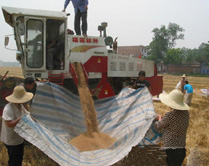
China's annual grain output may top 455 million tons this year, marking an end to a decline in production that started in 2000.
The rosy picture is based on two assumptions, said Sheng Huaren, vice-chairman of the Standing Committee of the 10th National People's Congress (NPC). One is that there will be no natural disasters between summer and fall. The other is that policies supporting agriculture are carried out at the grassroots level.
Major agriculture policies include lowering the agriculture tax, giving subsidies directly to grain growers and setting minimum purchasing prices for staple grain products.
Thanks to the incentives, there are signs that Chinese farmers have regained an enthusiasm for grain production, Sheng told the top legislature while reporting on the implementation of the Land Management Law Thursday.
Since April this year, the 10th NPC Standing Committee has dispatched 12 inspection groups to different places around the country.
The 20-page report is based on the two-month investigation. Although the policies helped farmers start planting again, many are concerned about whether the policies will last.
"It is urgent to set up a long-term mechanism to support grain production and increase farmers' income," said Sheng, noting that food security directly affects the country's social stability.
In the last few years, low returns have pushed farmers to grow less grain. Lots of them turned to doing odd jobs in cities, leaving farmland idle or little cared for.
"It is a major cause behind the continued shrinking of grain output since 2000," said Sheng.
The country's grain output, which was 510 million tons in 1998, plummeted to 430 million tons last year, the lowest point during the past 14 years, according to the Ministry of Agriculture.
"Besides, the reduction of farmland contributed to the decline of grain output," said Sheng.
Farmland was 123.4 million hectares by the end of 2003, dropping 6.7 million hectares since 1996, said the Ministry of Land and Resources.
Inspectors found recent campaign to clear up illegal land appropriations achieved preliminary results, said Sheng.
For instance, more than 3,700 investment and development zones nationwide were cancelled as of earlier this month, resulting in the rehabilitation of 110,000 hectares of land.
Sheng said before the campaign, there were more than 6,000 investment and development zones around China, taking up 3.5 million hectares of land, most of which was high-yield farmland.
He noted that the conflict between safeguarding farmland and expanding construction will exist for a long time and even become sharper in the course of industrialization and urbanization.
"Many local governments in eastern, central and western regions have very strong opinions on land occupation for economic development," said Sheng. "But the border of crop land is a red line that nobody can infringe. Governors should take full responsibility to safeguard the area of farmland."
Another problem exposed during the inspection is that many local governments defaulted, held back or embezzled farmers' compensation for land expropriation, said Sheng.
By the end of February this year, nearly 10 billion yuan (US$1.2 billion) worth of compensation had been held back by governments at various levels, said Sheng.
(China Daily June 25, 2004)
|

